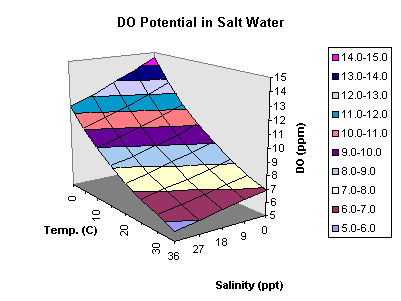Water Quality Monitoring: Conductivity
Conductivity
- At present there is no water quality index associated with conductivity, although some values may be better than others for a particular body of water. Abrupt changes in conductivity might indicate that water or wastes are being diverted into the stream from a new source.
- Conductivity can be used as a measure of total dissolved solids (TDS). These solids are usually composed of the sulfate, bicarbonate, and chlorides of calcium, magnesium, and sodium. Estimate TDS in ppm by multiplying conductivity (uS/cm) by 0x67.
- The TDS measurement differs from the total solids measurement in that total solids also includes suspended material that is not dissolved.
- Conductivity is also a good measure of salinity in water. The measurement detects chloride ions from the salt. Salinity affects the potential dissolved oxygen levels in the water. The greater the salinity, the lower the saturation point.
Test Equipment
- LaMotte TDS Tester 3 (Code 5-1758)
- Very small standard slot screwdriver
- TDS/Conductivity standard solution 442-300
- LaMotte thermometer (Code 1066) with no strings attached (Compare with temperature change directions.)
- Small plastic cup
- Wash bottle containing demineralized water
- Waste container
Additional Data
In order to convert conductivity to salinity and check whether the salinity significantly lowers the dissolved oxygen saturation point in the water, a temperature measurement is needed. One is usually taken when the dissolved oxygen sample is collected.
Procedure
Calibration
- It may be more convenient to perform the calibration indoors just before heading to the test site.
- Remove the cap on the tester (5-1758) and fill the small plastic cup with the standard solution far enough that the electrode on the bottom of the tester will be covered, but the tester won't fall in to over the maximum immersion level marking and the buffer solution won't overflow the cup.
- Press the on/off button once to turn on the tester and place it and the thermometer into the buffer solution for one or two minutes until both instruments have acclimated to the water temperature.
- Read the thermometer to the nearest 0.1 degree and use the chart on the back of the standard solution bottle to find the conductivity for the measured temperature. Interpolate between the temperatures if possible.

- Stir the solution a little and then use the screwdriver to turn the screw on the back of the tester and adjust the reading to match the calculated value.
- Rinse the electrode and thermometer with demineralized water and pour the used water and used standard solution into the waste container.
- Replace the cap on the tester.
Measurement
- At the test site remove the cap, press the on/off button to turn on the tester, and dip the electrode two to three centimeters into the creek at arm's length. It may be possible to hold a thermometer or pH tester at the same time and make all measurements at once.
- Wait three minutes for the tester to adjust to the water temperature and stabilize. Stir slowly back and forth while waiting.
- Note the reading and record it.
- Press the on/off button again to turn it off and replace the cap.
Calculations
- Collect conductivity (uS/cm) and water temperature (C) data.
- Use spreadsheet or calculator to convert conductivity and temperature data to salinity value.

- Use salinity and temperature values to compute saturation point for dissolved oxygen.

- Compare saturation point with salinity correction to saturation point without.
- If there is a significant difference, salinity should be accounted for in dissolved oxygen calculations.
More on Water Quality Monitoring
|



